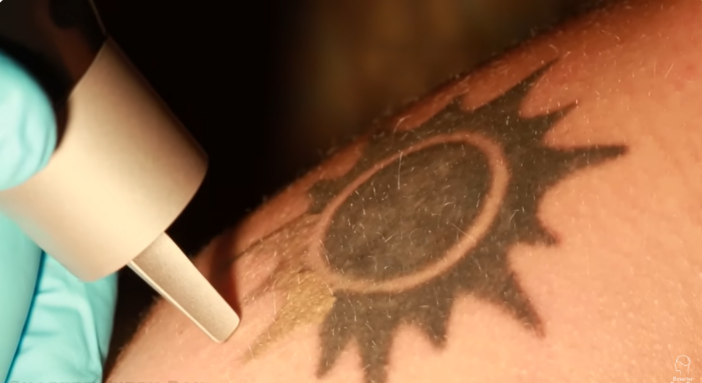Wedding ring tattoos have surged in popularity over the past few years as couples seek permanent symbols of their commitment. But what happens when that commitment changes? Whether due to divorce, career changes, or simply design regret, many people find themselves contemplating tattoo removal. Let’s explore everything you need to know about wedding ring tattoo removal in 2025.

The Rise of Wedding Ring Tattoos
Wedding ring tattoos have gained significant traction as alternatives to traditional metal bands. The appeal is understandable – they’re permanent, can’t be lost, and typically cost much less than traditional rings, with prices ranging from $100-$2,000 compared to the average $5,500 for a conventional engagement ring and band set.
Popular designs include simple bands, infinity symbols, dates or initials, and minimalist linework. These tattoos are almost exclusively placed on the ring finger of the left hand, mirroring the placement of traditional wedding rings.
While generally created with black or dark grey ink for longevity, these tattoos face unique challenges. Unlike tattoos on other body parts, finger tattoos tend to fade faster due to several factors: frequent hand washing, constant exposure to sunlight, and the rapid skin cell turnover on hands. The fine skin and limited fat in the fingers also make ink retention difficult, which can lead to blurred lines or patchy fading over time.
Why People Remove Wedding Ring Tattoos
Divorce remains the most common reason for wedding ring tattoo removal, which isn’t surprising given global divorce rates of 40-50% in Western countries. However, many non-divorce reasons prompt removal as well:
- Career changes that require more conservative appearance standards
- Design regret as style preferences evolve
- Skin reactions, including allergic responses or ink migration
The psychological aspects of removal can be complex. For many, erasing the tattoo represents closure and a new beginning. Others experience mixed emotions throughout the process – relief mingled with sadness as they literally erase a symbol of what was once a profound commitment.
Modern Tattoo Removal Technologies
Tattoo removal has evolved dramatically in recent years, with several options available:
Laser Removal: The Gold Standard
Laser remains the most effective and popular method for removing finger tattoos. Two main technologies dominate the field:
Q-switched lasers (Nd:YAG, Alexandrite, Ruby) deliver short, high-intensity pulses that break down ink particles, allowing your body to naturally eliminate them.
Picosecond lasers (like PicoSure and PicoWay) represent the newest technology. These deliver ultra-short pulses that shatter ink into tiny particles, resulting in faster clearance with fewer sessions and reduced scarring risk – particularly beneficial for delicate finger skin.
Non-Laser Alternatives
While laser removal is preferred, alternative methods include:
Surgical excision: The tattooed skin is cut out and the wound sutured. While highly effective for very small tattoos, this always leaves a scar and is rarely used for wedding band tattoos that encircle the finger.
Dermabrasion: This method uses abrasive devices to sand off layers of skin. It’s rarely used on fingers due to high scarring risk and unpredictable results.
Chemical removal and creams: These options lack scientific backing and are generally not recommended by dermatologists.
Factors Affecting Removal Success
Several factors influence how effectively a wedding ring tattoo can be removed:
Ink Colors and Composition
Black ink responds most effectively to laser treatment as it absorbs all laser wavelengths. In contrast, colors like green, blue, and yellow can be more resilient. This is why most wedding ring tattoos use black or dark grey ink – not just for aesthetics, but also for easier potential removal.
Skin Tone Considerations
Darker skin tones require more careful approach during laser removal to prevent hypopigmentation (lightening of the skin). Experienced practitioners will adjust laser settings accordingly.
Age and Quality of the Tattoo
Older, already-fading tattoos typically respond better to removal treatments. Professional tattoos with precise application usually require more sessions than amateur tattoos, which often have inconsistent ink depth.
Preparation and Aftercare
Proper preparation and aftercare significantly impact both comfort and results:
Before Your Appointment
Consult with a board-certified dermatologist or laser specialist who has experience with finger tattoo removal specifically. Avoid sun exposure for at least two weeks before treatment, and don’t apply any creams or lotions to the area on the day of treatment.
After Treatment Care
The first 48 hours are critical. Keep the area clean, apply cold compresses to reduce swelling, and use prescribed ointments. Avoid submerging your hands in water for prolonged periods, and definitely skip hot tubs, swimming pools, and saunas until fully healed.
In the weeks following treatment, protect the area from sun exposure and keep it moisturized with fragrance-free products. Avoid picking at any scabs or blisters that form.
Costs and Considerations
Laser tattoo removal for wedding ring tattoos typically costs between $200-$500 per session. With multiple sessions required, total costs can reach $2,000-$4,000 for complete removal.
Most insurance plans don’t cover tattoo removal as it’s considered cosmetic. However, many clinics offer financing options or package deals that reduce the per-session cost when multiple treatments are purchased upfront.
New Technologies on the Horizon
The field of tattoo removal continues to advance rapidly. In 2025, we’re seeing promising developments:
- Advanced fractional picosecond lasers with improved targeting capabilities
- AI-driven treatment customization that analyzes your specific ink composition and skin type
These innovations are making removal faster, less painful, and more effective – especially for challenging areas like fingers.
Making Your Decision
If you’re considering removing a wedding ring tattoo, take time to research providers thoroughly. Look for specialists with extensive experience in finger tattoo removal specifically, and ask to see before-and-after photos of similar work.
Remember that complete removal may not always be possible, but significant fading can almost always be achieved with the right approach and technology.
Finger tattoos present unique challenges due to their location, frequent exposure, and the thin skin covering them. While modern technology has made removal more effective than ever, managing expectations remains important.
Whether you’re moving on from a relationship that has ended or simply seeking a fresh start, removing a wedding ring tattoo can be both physically and emotionally challenging – but with the right support and technology, it can also be remarkably rewarding.






